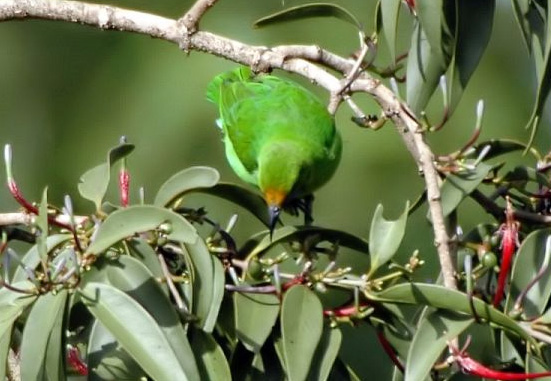| Kingdom: Animalia Phylum: Chordata Class: Aves (Birds) Order: Passeriformes Family: Irenidae |
|
Golden-fronted Leafbird (Chloropsis aurifrons) is a widespread resident in India. Three subspecies: C. aurifrons aurifrons (chin and throat blue), C. aurifrons frontalis (chin and throat black, larger) and C. aurifrons insularis (chin and throat black, smaller). Size: 18-19 cm Identification: The Golden-fronted Leafbird is brightly colored, depicting vibrant colors of green, orange-yellow, black, blue, and turquoise. Males are pale green and the undersides are a lighter shade of green. The area from the forehead to the crown’s center is an orange-yellow shade and the cheeks, throat and breast are black, and the chin a deep blue. The bend of the wing has a turquoise-blue patch of color. Females are not colored as vibrantly as the males and are slightly smaller. Chloropsis aurifrons are long, with relatively short round wings. The legs and toes of the Leafbird are short, sturdy and strong. The bill of the Leafbird is slender with an upper mandible that has a slight downward curved, and encloses the spiked tongue that enables them to easily feed on nectar. The plumage of the Leafbird is rather dense and fluffy. Although not much is known about the physical differences between sexes and ages, the juveniles tend to resemble the females. Leafbirds are distinguished uniquely by the vibrant colored plumage that they display. Distribution: Golden-fronted Leafbird is primarily distributed throughout southeast Asia and is a widespread resident in India. The Leafbird is found in different environments, ranging from forests to dry scrubs, although it is primarily a tree dweller and seldom touches the ground. Habits: Chloropsis aurifrons are arboreal eaters. They are strong, long-lived birds that are very aggressive. Cocks are more aggressive than the hens. Females seem to get along with other birds, but the males are aggressive towards other birds including other male and female con-specifics. The Golden-fronted Leafbird is also known to sing melodic songs with a cheerful whistle. Not much is known about the courtship behavior, but it seems to be rather excited, primarily consisting of chasing and screeching between the male and female. It’s known that the male tend to hang upside down under the hen on the same twig. Little is known about the social behavior of C. aurifrons, but they are known to flock with several different species of birds. Food: The diet of the Golden-fronted Leafbird consists primarily of nectar, insects, spiders, and fruits such as guava, berries and figs. Breeding: Breeding season May to August. Nest is a shallow cup made of fine twigs, moss, leaves etc., and is attached to a thin branch high up in a tree. After the eggs are laid, the care of the egg is shared equally between the male and female. They rotate turns incubating the eggs until they are hatched. There are 2-3 eggs per clutch. Eggs are usually pale cream speckled or lined with a brown or red-brown color. After approximately 14-15 days of incubation, the eggs will hatch. Hatchlings are rather small and develop slowly for the first 3-4 days. The chicks open their eyes at about six days, and leave the nest after about 13 days. |
| |

